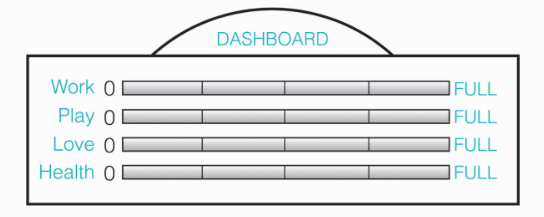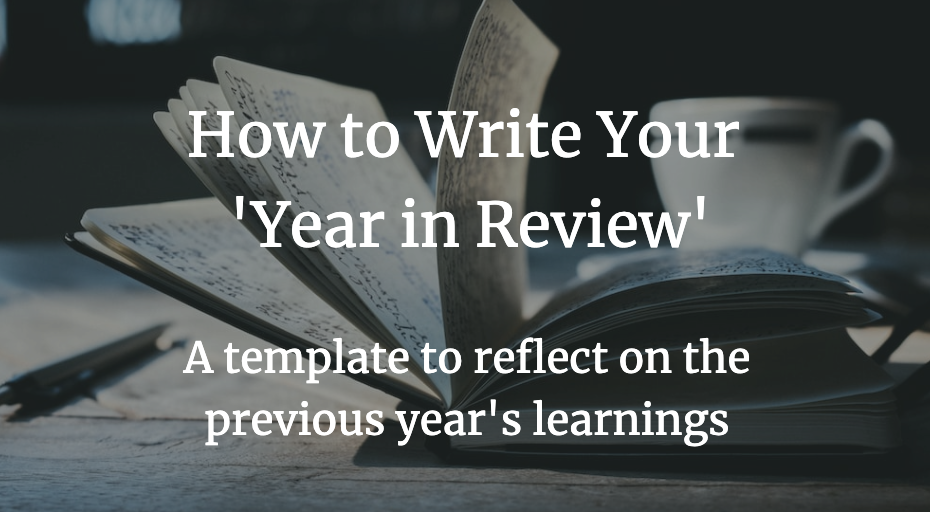Every December, I sit down to write my year in review—capturing the highs, the lessons learned, and my aspirations for the coming year. This reflective practice has proven invaluable, providing me with profound insights and a roadmap for personal growth.
It’s a great practice which I would highly recommend. I have year in reviews going back to 2011 and paging through them helps me appreciate how far I’ve come. Depending on the year I’ll spend anywhere from an hour to half a day’s worth of time putting together my review. While the format has changed over the years, I want to share my current approach.
My Year in Review Format
I start my year in review by outlining my doc into six sections.
- Big events of the year
- What I learned
- Where I am (Work, Play, Love, Health)
- What to keep doing? What to add or subtract?
- Review last year’s intentions
- Set next year’s intentions
Start by writing down the main points
I recommend filling out each section with bullet points or key ideas first, rather than tackling this section by section. This is because diving right in and writing out the section can easily suck up a lot of mental energy and it’s helpful to capture the main points first.
After I’ve captured the main content in each section, I’ll go back in and write more in-depth reflections into each section.
The Six Sections
Big Events of the Year
Big Events of the Year is a great opportunity to look back at the big picture of the year. I’ll pull open my calendar and create a bulleted list of the major events of the year, like travel, occasions, big milestones. Sometimes I’ll even look at other respositories of data (like sorting my purchase or order history, book lists, emails) to try to pull out themes. In addition to dated events, I’ll also add in big themes or ideas that have been part of the year.
For example, last year my list included:
- Zoe enters daycare (February 14)
- Publicly launching my executive coaching practice
- Dexter gets hit by a car during Thanksgiving
- Community: joining Leaders In Tech Board, Menlo Park Library Commission
- Seattle trip with family
- New York for Thanksgiving
- The great debate on how to splitting holidays with family
- COVID and its impact
What I Learned
What I Learned is an opportunity to reflect on new ideas and lessons learned for the year.
Another way to frame this: If you had an opportunity to go back and give yourself advice at the start of the year now that you are at the end, what would you tell yourself?
Where I Am
Where I am is a recent add borrowed from the book Designing Your Life which I’ve previously written about. It’s basically a pulse check on how I’m doing holistically. I particularly like how intentional they’ve been about creating categories distinct from work because it’s easy for me to get caught up in that category.

Here’s how they define their categories
- Work — not just what you’re paid to do, but also include other duties such as second jobs, consulting, advising, volunteering, home-making, houseworking.
- Play — any activity that brings joy just for the sake of doing it, which can include organized activities or productive endeavors so long as they’re done for fun and not merit.
- Love — the health of your primary relationship, children, pets, community, or anything else tied to affection. Where is the love flowing in your life, from you or from others?
- Health — not just physical health, but an engaged mind and satisfied spirit.
For each of these categories, I give myself a percentage score that reflects how full my tank is in that area. Sometimes I’ll add bullets in to help myself understand how I’m doing in those categories. The goal is not to be FULL on every category (that sounds overwhelming) but to reflect on if those levels are where you’d like them to be.
What to keep doing? What to add and subtract?
This section flows naturally from the Where I Am section. I’ll look at my current state and think about how I’d want to adjust it to meet my needs.
Often this space will become a repository for my ideas on what I could add or subtract to my life. For example, last year I noticed that I’m very low in the category of Play. I haven’t been doing much for the sheer joy of doing it. I brainstormed a list of activities that fall into this category. When I think about what to subtract, sometimes it’s an exercise of what I actively didn’t enjoy from the year but often it’s considering what I wouldn’t miss doing.
Review Last Year’s Intentions
Review Last Year’s Intentions is an opportunity to look at what you set out to do in the past year and reflect on what worked and what didn’t and why. If I had resolutions from last year, I’ll write about how I did against them and what I learned. If I didn’t, then I might take some time and reflect on how I entered the past year and if I am where I thought I’d be.
Set next year’s intentions
After thinking about the past year, it’s time to turn our gaze toward the future. This section provides a space for planning the year ahead.
- Resolutions – writing down a list of measurable goals/areas where I want to improve for the next year and thinking about how I can set up my environment today to achieve them.
- Wishes – what do I wish for myself by the end of next year? writing down a list of wishes that I have for my future self at the rest of the year
- Intentions – how do I want to approach the coming year and what are my intentions on where I want to focus my time and energy?
Want to try this for yourself?
If you’d like to try this for yourself, here’s a template that I’ve created with the prompts and examples.
If you tried this or found it helpful, please support me by letting me know and sharing with others!
